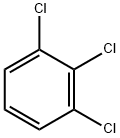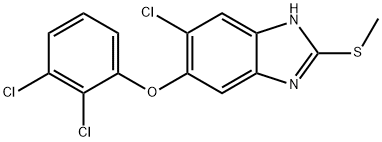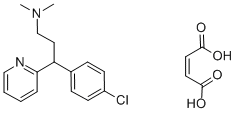1,2,3-Trichlorobenzene solution , analyticalstandard,0.103mg/mlinisooctane , 87-61-6
CAS NO.:87-61-6
Empirical Formula: C6H3Cl3
Molecular Weight: 181.45
MDL number: MFCD00000537
EINECS: 201-757-1
PRODUCT Properties
| Melting point: | 51-53 °C (lit.) |
| Boiling point: | 218-219 °C (lit.) |
| Density | 1,69 g/cm3 |
| vapor density | 6.25 (vs air) |
| vapor pressure | 0.07 mm Hg ( 25 °C) |
| refractive index | 1.5693 (estimate) |
| Flash point: | 260 °F |
| storage temp. | 2-8°C |
| solubility | 0.02g/l |
| color | White crystals or platelets |
| explosive limit | 2.5-6.6%(V) |
| Water Solubility | INSOLUBLE |
| Merck | 14,9630 |
| BRN | 956882 |
| Henry's Law Constant | 8.36, 10.3, 13.2, 20.6, and 26.5 at 2.0, 6.0, 10.0, 18.0, and 25.0 °C, respectively (EPICS-SPME,
Dewulf et al., 1999) |
| LogP | 4.139 at 25℃ |
| CAS DataBase Reference | 87-61-6(CAS DataBase Reference) |
| NIST Chemistry Reference | Benzene, 1,2,3-trichloro-(87-61-6) |
| EPA Substance Registry System | 1,2,3-Trichlorobenzene (87-61-6) |
Description and Uses
Trichlorobenzenes (TCBs) are synthetic chemicals that occur in three different isomeric forms. The three chlorinated cyclic aromatic isomers are 1,2,3-trichlorobenzene (1,2,3-TCB), 1,2,4-trichlorobenzene (1,2,4-TCB), and 1,3,5-trichlorobenzene (1,3,5-TCB). 1,2,4-TCB is one of the 188 chemicals designated as a hazardous air pollutant under the Clean Air Act.
Trichlorobenzenes are primarily used as solvents in chemical manufacturing industries. 1,2,4-Trichlorobenzene is economically the most important isomer. 1,2,4-Trichlorobenzene is used as a solvent in chemical reactions to dissolve oils, waxes, and resins. Furthermore, it is also used as a dye carrier. 1,2,3- Trichlorobenzene is used as an intermediate for pesticides production, pigments, and dyes. 1,3,5-Trichlorobenzene is not marketed commercially and has very limited use as a chemical intermediate. Besides, trichlorobenzenes can also be used as degreasing agents, as septic tanks and drain cleaners, and as an ingredient in wood preservatives and abrasive formulations. Other minor uses include metal work, anticorrosive paint, and corrosion inhibitor in sprays. In the past, mixed isomers of trichlorobenzenes were used to control termites; however, their use has been discontinued.
Safety
| Symbol(GHS) |   GHS07,GHS09 |
| Signal word | Warning |
| Hazard statements | H302-H410 |
| Precautionary statements | P273-P301+P312+P330 |
| Hazard Codes | Xn,T,N |
| Risk Statements | 22-36/37/38-38-39/23/24/25-23/24/25-52/53-51/53 |
| Safety Statements | 36/37-26-45-61-36 |
| RIDADR | UN 3077 9/PG 3 |
| WGK Germany | 3 |
| RTECS | DC2095000 |
| Autoignition Temperature | 1059 °F |
| TSCA | Yes |
| HazardClass | 9 |
| PackingGroup | III |
| HS Code | 29036990 |
| Hazardous Substances Data | 87-61-6(Hazardous Substances Data) |
| Toxicity | LC50 2,177 to 3,084 μg/L (soil porewater concentration) for earthworm (Eisenia andrei) and 2,540 to 3,084 μg/L (soil porewater concentration) for earthworm (Lumbricus rubellus) (Van Gestel and Ma, 1993). |





